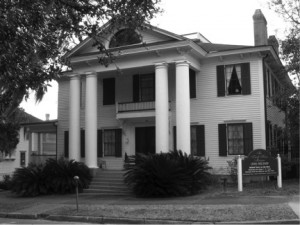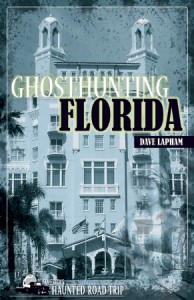Knott House Museum Tallahassee
By Dave Lapham
After a delicious lunch of pizza at the Monticello Pizza Kitchen, which, by the way, is also haunted, Betty, Lisa, and I headed for Tallahassee and the Knott House Museum just down from Florida’s Old Capitol in the Park Avenue Historic District. The area around what is now Tallahassee has been occupied by various indigenous and European cultures for twelve thousand years. Soon after the United States took possession of Florida from the Spanish in 1821, the Territorial Governor, William P. Duval, laid out the city, and in 1824 it became the territorial and later state capital of Florida. It is a beautiful city. Its rolling hills, wide boulevards, stately buildings, various college campuses, and numerous parks give Tallahassee a genteel ambiance.

And the Knott House with its handsome Greek Revival facade only adds to that atmosphere. The house was built in 1843 by free-black builder George Proctor as a wedding gift for Thomas Hagner and his wife, Catherine. Thomas died in 1848, but Catherine remained in the house and added major additions to the rear. She turned it into a boarding house, presumably to supplement her income. At the end of the Civil War, Union General Edward McCook commandeered the home for his headquarters. He read President Lincoln’s Emancipation Proclamation from the front steps on May 20, 1865. Today a ceremony on May 20 every year commemorates the event.
The Hagner family owned the house until 1883 when they sold it to a Dr. Betton, who maintained his office in the building. Following a succession of owners, William and Luella Knott finally bought the house in 1928. The Knotts were an influential family in Tallahassee. William was variously the state treasurer and comptroller and ran unsuccessfully for governor. Luella, a poet and community volunteer, was a staunch supporter of women’s rights. She homeschooled her three children, Mary Franklin, James Robert, and John Charles (“Charlie”), wrote and published countless poems, and filled her house with the antiques she loved. She also filled her home with poetry, which even today is scattered around the rooms, tied to various items with silk ribbons. Because of that, the house is known as the “The House That Rhymes.”
William died in April 1965 at 101 years of age; Luella fell and died a few days after that. Charlie then moved into his family home, determined to preserve it as his parents had left it. And when he died in 1985, he left it to the State of Florida, stipulating that it be maintained as a museum house. The Historic Tallahassee Preservation Board took charge of the property, and after spending more than one million dollars and several years of preservation and restoration efforts—the restoration team found evidence of earlier fires, which had to be addressed—the museum finally opened to the public in 1992.
Walking through Knott House Museum
Walking through the house is eerie. It is so complete and looks so lived in, I expected to see the lady of the house, Mrs. Knott, around every corner and in every room. There are four thousand books, three hundred pieces of furniture, and fifteen hundred personal items and art work. Books lie open on tables. Personal effects are strewn about. I would not have been surprised to see a steaming cup of coffee sitting on the counter in the kitchen, waiting for Charlie to come in and pick it up. I felt as if I were invading the Knotts’ privacy, as if I shouldn’t be there. But it is a beautiful house and extremely well maintained. Tours in the past used to be self-guided, but are now led by knowledgeable docents. That’s probably a good idea. Betty and her BBGT crew have been through the house many times. In past years, the curator hosted a “Fear Knott” event around Halloween as a fund-raiser. Betty, Lisa, and their team gave presentations and “haunted” tours through the house in the evenings. They also have conducted paranormal investigations in the building and have spent many nights there after the museum was closed. The most frequent experiences reported by BBGT investigators, visitors, and staff are footsteps. They are heard throughout the house. Sometimes they are very heavy like a man’s, and at other times lighter, as if a woman were walking around. They could very well be Charlie’s father, his mother, or Charlie himself. All three had a special passion for the house.
Once in the days when the tours were self-guided, a visitor rushed down the stairs breathless. A staff member was standing at the bottom. The visitor, quite excited, said, “I believe I’ve just seen a ghost!” The staff member, who’d had her own experiences, asked the lady what had happened. “Well, I just went into the first room on the right at the top of the stairs, and there was an older woman dressed in old-fashioned clothes standing there. At first, I thought she was a docent or something, but she just stood there and looked at me. And then she evaporated into thin air!” On several other occasions, visitors have reported seeing people throughout the house who appeared to be visitors as well, only to vanish before their eyes. Perhaps Charlie, his parents, and maybe even his friends are walking the halls. In the past, various staff members have reported items being moved around. Perhaps a book has been taken from a shelf in the library and left on a table somewhere else, pictures rearranged, fireplace tools misplaced, pages of music on the piano turned.
The Knott House Museum is a “must-see”

At the end of each day, the outside doors to the Knott House are closed and locked, of course, but inside doors are always left open to provide air circulation. Often when staff members arrive in the morning to unlock the house, those inside doors are all closed. And passersby late at night have reported seeing lights switching on and off inside the locked and empty house, as if someone was going from room to room.
In the Knott House Museum, Betty and her BBGT investigators have experienced just about every activity others have reported. They’ve also had another experience. During one investigation, Betty and Lisa were sitting downstairs, quietly listening, when they heard humming coming from upstairs. It sounded like a woman softly humming a lullaby to a baby. When they went through every room in the house to try to find the source of the sound, they could hear it everywhere but were never able to identify its location. The Knott House Museum is a “must-see” stop for anyone visiting Tallahassee. The visitor will find the most completely restored nineteenth-century house in Florida, and who knows? You might get to meet Mr. and Mrs. Knott or their son, Charlie.
Enjoy Ghosthunting Florida from the safety of your armchair or hit the road using the maps, the haunted sites travel guide, and the “Ghostly Resources.”